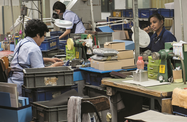With troubled weather patterns at home squeezing supply while demand from overseas grows, Malaysian rubber can command high prices on international markets these days.
This has its benefits for smallholders, who produce 90% of Malaysia's rubber. While for one of the country's major export industries - latex gloves and other rubber products - demand in international markets is expected to be strong and some cost increases can be translated into higher prices.
"From being almost solely an exporter of raw natural rubber, the industry has since developed to include a wide range of products. This diversity of products has helped in adding to the competitiveness of the Malaysian industry despite a challenging market environment," Teo Suat Cheng, CEO of the Malaysian Rubber Export Promotion Council, told OBG.
Domestic manufacturers are proving resilient in the face of the latest price volatility, through improved cost management and increasing the proportion of their products going to quality markets.
While historically Malaysia has long been well known for its rubber plantations, in recent years, the tree has increasingly made room for its faster growing cousin, the oil palm. According to statistics from the Malaysian Rubber Board (LGM), in 1998 some 1.28m ha were planted with rubber in Peninsula Malaysia, with another 260,000 ha in Sabah and Sarawak. By last year, however, the numbers had fallen to 732,280 ha on the peninsula and 228,600 ha in eastern Malaysia.
Yet global demand for natural rubber (NR) has continued to rise – albeit at the same time as a continuing hike in demand for its synthetic rival (SR). According to the International Rubber Study Group, production of NR in 1998 worldwide stood at 6.63m metric tonnes (MT), while output of SR was 9.88m MT. Ten years later, the numbers of both had risen to 10.03m MT and 12.74m MT, respectively. Global consumption followed production closely throughout the 10-year period too, from 6.57m MT of NR and 9.87m MT of SR in 1998, to 10.17m MT of NR and 12.6m MT of SR in 2008.
“There is always demand, however being a high cost producing country, Malaysia cannot compete with low-cost producers such as Thailand and Indonesia. Malaysia therefore needs to move downstream producing value-added products,” said Dr Salmiah Ahmad, Director General of the Malaysian Rubber Board. “The rubber products sector, at least so far as natural rubber products are concerned, has an advantage, as these are natural products, biodegradable and environmentally friendly. Rubber holdings are carbon sinks and help in alleviating global warming,” she added.
Fuelling a lot of the increasing global demand globally has been China’s developing economy, which is highly dependent on rubber imports to fulfil orders at its booming car plants, in particular. The South-east Asian economies of Malaysia, Indonesia, Thailand and Vietnam are the closest for fulfilling these needs, with these four responsible for some 93% of all global exports currently.
The China factor is very visible too in Malaysia’s NR export figures. According to the LGM, exports of NR to China in 2001 accounted for just 10.4% of the total, at 85,448 MT. This then shot up, peaking at 405,616 MT just five years later, in 2006. The economic downturn impacted the figures, but despite this, in 2009, China still accounted for 39% of all Malaysia’s NR exports, at 274,013 MT. The only other country in the same league is Germany, although its share of the total went from 14.4% in 2001 to 11.7% last year.
Thus, demand continues to be strong for NR exports. Now though, supply in Malaysia has been hit badly by poor weather. Meteorological experts are predicting that a La Niña-style weather pattern may continue to bring additional rain to Malaysia during the rest of the year. Yet put China and the weather together and the rationale behind a jump in the price of Standard Malaysian Rubber (SMR) from $1.12 per kg in 2008 to $3.94 per kg on October 15 becomes clear.
In tandem with this hike in prices has been an increase in input costs for Malaysian manufacturers of NR-based products. Chief among these are rubber glove manufacturers, with the 45 members of the Malaysian Rubber Gloves Manufacturing Association (MARGMA) responsible for some 60% of the entire world’s rubber glove supply.
The MARGMA has recently spoken out, saying that their members should increase their selling prices to compensate for the higher input costs – and for the declining US dollar, in which their export products are generally sold.
This would follow on price hikes that many manufacturers have already put in place, while some businesses have also switched to using SR for several of their products. A synthetic rubber glove, known as the nitrile glove, has been on the market for some time, although it has always been more expensive than NR-based gloves – until now that is, with the NR price hike.
A shift to nitrile gloves has also meant a shift to the traditionally higher-priced end of the market, particularly in health, which buys these in preference to NR latex where concern over latex allergies occurs. Thus Malaysia’s rubber glove producers are being obliged to head up the value chain, as relative prices change.
Sector managers remain generally optimistic, despite the higher costs. Many have experienced similar price volatilities in the past, and have overcome shifts in demand – for example, when the H1N1 bird flu virus was declared no longer a pandemic, earlier this year, cutting demand. At the same time, growth remains built-in while export markets such as China continue to experience strong economic growth.

